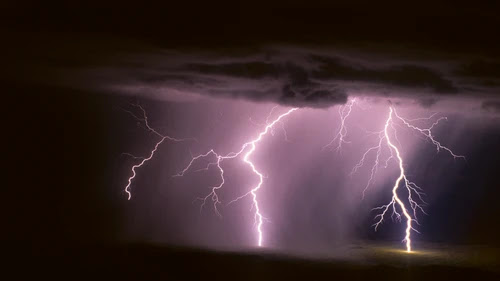A bolt of lightning that struck Glen Ellyn, Illinois, has sparked an alternate vision of how life may have emerged on Earth, while also shedding light on the odds of alien life on other worlds, according to a new study.
It all started in 2016, when the geology department of Wheaton College received a call from a local resident describing an odd mineral clump that had formed after lightning hit their yard. Benjamin Hess, who was pursuing his undergraduate degree at Wheaton at that time, was among the researchers who studied this fascinating “fulgurite,” which is the term for the glassy formations created by contact with lightning bolts.
“I was just generally interested in how it formed and what might be inside of it,” Hess said in a call. “When I started analyzing it, I started finding some weird metals in it that I couldn't identify.”
Hess, who is now a graduate student at Yale University's Department of Earth & Planetary Sciences, eventually identified a phosphorus-rich mineral called schreibersite inside the fulgurite.
In recent years, researchers have suggested that schreibersite could be an essential piece of one of the greatest unsolved puzzles in science: how living things somehow emerged from non-living material on Earth billions of years ago—and whether this amazing transformation could happen on other planets.
Hess and his colleagues use their in-depth examination of the Glen Ellyn fulgurite to suggest that lightning bolts may have been a key source of schreibersite on young Earth, which could explain where early organisms sourced the life-giving element of phosphorus, according to a paper published on Tuesday in Nature Communications.
“Phosphorus is one of the essential elements for life,” explained Hess, who led the new study. He noted that it is the “backbone” of the double helix structure of DNA and is a building block of the membranes that keep cells safe and enclosed.
“But the difficulty is,” he continued, “while phosphorus is in most rocks on Earth, it's in minerals that are basically insoluble and unreactive. There's a lot of phosphorus around, but no way to make bio-molecules out of it.”
As a result, scientists have long pondered where early lifeforms on Earth sourced the phosphorus that was essential for their genesis. One possible solution is schreibersite: this mineral is relatively soluble in water and could have leached out its phosphorus into latent ecosystems on Earth. Though it is rare on Earth, previous studies have suggested that the mineral may have been delivered by meteorite impacts that produced an ancient supply of extraterrestrial bioreactive phosphorus.
Now, Hess’s team suggests that lightning-derived schreibersite could be a better fit for the mystery of Earth’s missing phosphorus, though it would not rule out extraterrestrial sources of the mineral.
Just like today, lightning storms would have frequently pelted the tropical latitudes of our young planet, potentially enriching those areas with anywhere between 110 and 11,000 kilograms of phosphorus each year, according to the study.
Meteorite strikes, in contrast, dropped off significantly over the first billion years of Earth’s life, so they might not have been such a steady source of schreibersite by the time life is estimated to have appeared on our planet some 3.5 billion years ago.
The team also notes that meteorites are enormously destructive to local impact areas, while lightning strikes would be a gentler presence that would be less likely to “interfere with the delicate evolutionary steps required for complex prebiotic synthesis,” according to the study.
“Lightning is great because it's constant through time and it is much less destructive,” Hess said. “It destroys a small area instead of a big area. But the difficulty of lightning is that each individual strike provides less phosphorus; a lot less than a giant meteorite.”
Because it’s unclear exactly how much schreibersite is typically contained in fulgurites, the team’s estimate of the abundance of lightning-derived phosphorus on early Earth ended up encompassing a wide range.
It’s possible that lightning strikes could have created a significant amount of bioreactive phosphorus on early volcanic islands in the tropics, which contain the kind of clay-rich soil that is ideal for schreibersite formation. But to be sure, Hess said he and his colleagues plan to study schreibersite abundance in fulgurites formed in analogous volcanic regions today, such as Hawaii.
“If we go out and collect 20 lightning strikes, and half or more of them have a lot of reduced phosphorus or schreibersite in them, then that's way better than what I estimated,” he noted. “I was pretty conservative in the paper.”
“But if there's no reduced phosphorus, then our hypothesis doesn't bear out, unfortunately,” Hess said. “But that's something that could be tested.”
In addition to its implications for understanding our own origins as the only known life-bearing world, the team concludes the study by noting that the presence of lightning could “potentially indefinitely [prolong] the window for the emergence of life on Earth-like planets.”
“If you have something like Earth, which has a sustained weather system and atmosphere, then you have lightning throughout the entire planetary history, so that source of phosphorus is always there,” Hess concluded. “There’s always the opportunity for life to form if the other conditions are right.”


so the Frankstein story is true.
ReplyDelete